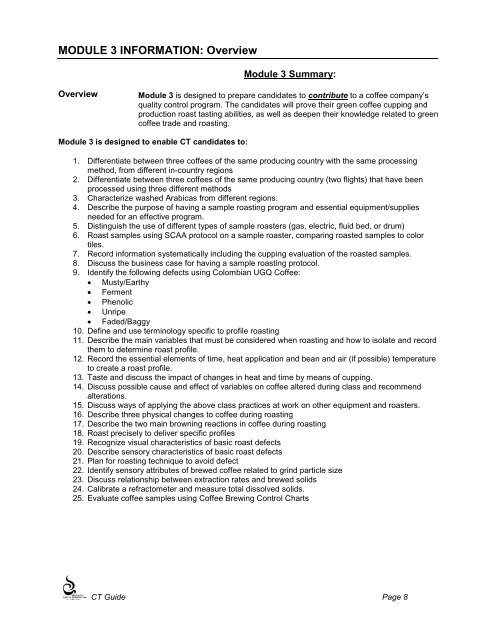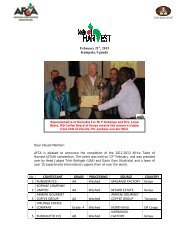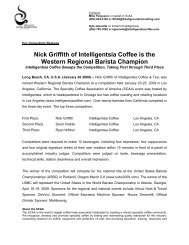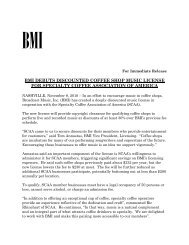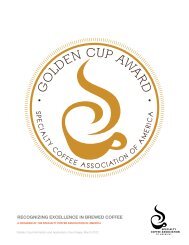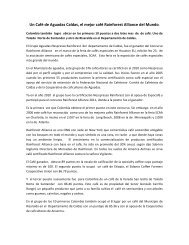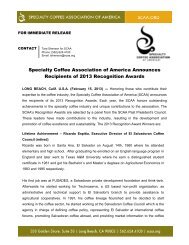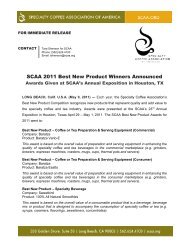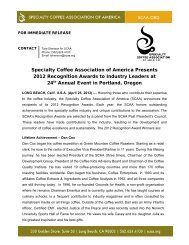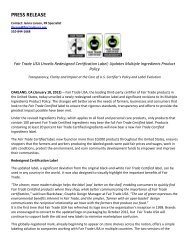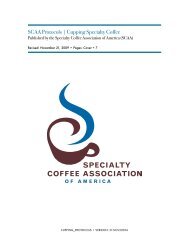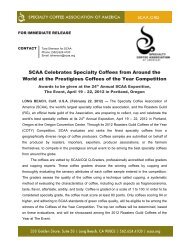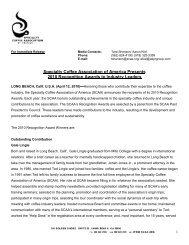Coffee Taster Certificate Program Handbook - SCAA
Coffee Taster Certificate Program Handbook - SCAA
Coffee Taster Certificate Program Handbook - SCAA
Create successful ePaper yourself
Turn your PDF publications into a flip-book with our unique Google optimized e-Paper software.
MODULE 3 INFORMATION: Overview<br />
Module 3 Summary:<br />
Overview<br />
Module 3 is designed to prepare candidates to contribute to a coffee company’s<br />
quality control program. The candidates will prove their green coffee cupping and<br />
production roast tasting abilities, as well as deepen their knowledge related to green<br />
coffee trade and roasting.<br />
Module 3 is designed to enable CT candidates to:<br />
1. Differentiate between three coffees of the same producing country with the same processing<br />
method, from different in-country regions<br />
2. Differentiate between three coffees of the same producing country (two flights) that have been<br />
processed using three different methods<br />
3. Characterize washed Arabicas from different regions.<br />
4. Describe the purpose of having a sample roasting program and essential equipment/supplies<br />
needed for an effective program.<br />
5. Distinguish the use of different types of sample roasters (gas, electric, fluid bed, or drum)<br />
6. Roast samples using <strong>SCAA</strong> protocol on a sample roaster, comparing roasted samples to color<br />
tiles.<br />
7. Record information systematically including the cupping evaluation of the roasted samples.<br />
8. Discuss the business case for having a sample roasting protocol.<br />
9. Identify the following defects using Colombian UGQ <strong>Coffee</strong>:<br />
Musty/Earthy<br />
Ferment<br />
Phenolic<br />
Unripe<br />
Faded/Baggy<br />
10. Define and use terminology specific to profile roasting<br />
11. Describe the main variables that must be considered when roasting and how to isolate and record<br />
them to determine roast profile.<br />
12. Record the essential elements of time, heat application and bean and air (if possible) temperature<br />
to create a roast profile.<br />
13. Taste and discuss the impact of changes in heat and time by means of cupping.<br />
14. Discuss possible cause and effect of variables on coffee altered during class and recommend<br />
alterations.<br />
15. Discuss ways of applying the above class practices at work on other equipment and roasters.<br />
16. Describe three physical changes to coffee during roasting<br />
17. Describe the two main browning reactions in coffee during roasting<br />
18. Roast precisely to deliver specific profiles<br />
19. Recognize visual characteristics of basic roast defects<br />
20. Describe sensory characteristics of basic roast defects<br />
21. Plan for roasting technique to avoid defect<br />
22. Identify sensory attributes of brewed coffee related to grind particle size<br />
23. Discuss relationship between extraction rates and brewed solids<br />
24. Calibrate a refractometer and measure total dissolved solids.<br />
25. Evaluate coffee samples using <strong>Coffee</strong> Brewing Control Charts<br />
CT Guide Page 8


